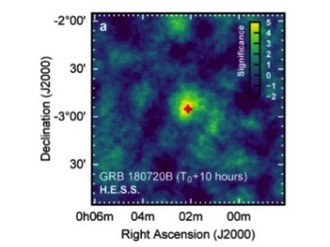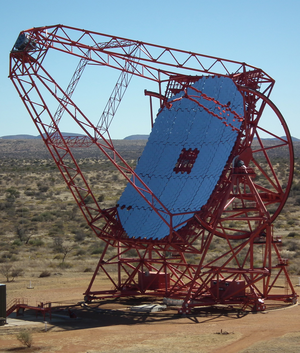
GRB 180720B in very-high-energy gamma light, 10 to 12 hours after the burst as seen by the large H.E.S.S. telescope. The red cross indicates the position of GRB180720B, determined from the optical emission of the GRB.(Credit: H.E.S.S. collaboration, email: contact.hess@hess-experiment.eu)
After a decade-long search, scientists have for the first time detected a gamma-ray burst in very-high-energy gamma light. This discovery was made in July 2018 by the H.E.S.S. collaboration using the huge 28-m telescope of the H.E.S.S. array in Namibia. Surprisingly, this Gamma-ray burst, an extremely energetic flash following a cosmological cataclysm, was found to emit very-high-energy gamma-rays long after the initial explosion.
Extremely energetic cosmic explosions generate gamma-ray bursts (GRB), typically lasting for only a few tens of seconds. They are the most luminous explosions in the universe. The burst is followed by a longer lasting afterglow mostly in the optical and X-ray spectral regions whose intensity decreases rapidly. The prompt high energy gamma-ray emission is mostly composed of photons several hundred-thousands to millions of times more energetic than visible light, that can only be observed by satellite-based instruments. Whilst these space- borne observatories have detected a few photons with even higher energies, the question if very-high-energy (VHE) gamma radiation (at least 100 billion times more energetic than visible light and only detectable with ground-based telescopes) is emitted, has remained unanswered until now.
On 20 July 2018, the Fermi Gamma-Ray Burst Monitor and a few seconds later the Swift Burst Alert Telescope notified the world of a gamma-ray burst, GRB 180720B. Immediately after the alert, several observatories turned to look at this position in the sky. For H.E.S.S. (High Energy Stereoscopic System), this location became visible only 10 hours later. Nevertheless, the H.E.S.S. team decided to search for a very-high-energy afterglow of the burst. After having looked for a very-high-energy signature of these events for more than a decade, the efforts by the collaboration now bore fruit. The data collected during two hours from 10 to 12 hours after the gamma-ray burst showed a new point-like gamma-ray source at the position of the burst. While the detection of GRBs at these very-high-energies had long been anticipated, the discovery many hours after the initial event, deep in the afterglow phase, came as a real surprise. The discovery of the first GRB to be detected at such very-high-photon energies is reported in a publication by the H.E.S.S. collaboration et al., in the journal Nature; on Nov. 20, 2019

The large central H.E.S.S. telescope with 614 m² mirror area that was used for the first detection of a GRB in VHE gamma-ray light. (Credit: MPIK / Christian Föhr, email: christian.foehr@mpi-hd.mpg.de )
Scientists from CAMK PAN are members of the H.E.S.S. Collaboration: Rafał Moderski, Bronisław Rudak, Andrzej Zdziarski, Włodzimierz Kluźniak and Jarosław Dyks.






